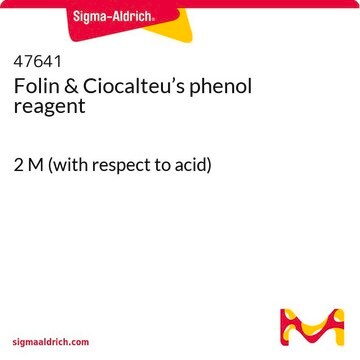If this product has an expiration or retest date, it will be shown on the Certificate of Analysis (COA, CofA). If there is no retest or expiration date listed on the product's COA, we do not have suitable stability data to determine a shelf life. For these products, the only date on the COA will be the release date; a retest, expiration, or use-by-date will not be displayed.
For all products, we recommend handling per defined conditions as printed in our product literature and website product descriptions. We recommend that products should be routinely inspected by customers to ensure they perform as expected.
For products without retest or expiration dates, our standard warranty of 1 year from the date of shipment is applicable.
For more information, please refer to the Product Dating Information document: https://www.sigmaaldrich.com/deepweb/assets/sigmaaldrich/marketing/global/documents/449/386/product-dating-information-mk.pdf
D9132
2,2-Diphenyl-1-picrylhydrazyl
Synonym(s):
1,1-Diphenyl-2-picrylhydrazyl radical, 2,2-Diphenyl-1-(2,4,6-trinitrophenyl)hydrazyl, DPPH
Select a Size
Select a Size
About This Item
Recommended Products
form
powder
Quality Level
color
green
mp
~135 °C (dec.) (lit.)
storage temp.
2-8°C
SMILES string
[O-][N+](=O)c1cc(c([N]N(c2ccccc2)c3ccccc3)c(c1)[N+]([O-])=O)[N+]([O-])=O
InChI
1S/C18H12N5O6/c24-21(25)15-11-16(22(26)27)18(17(12-15)23(28)29)19-20(13-7-3-1-4-8-13)14-9-5-2-6-10-14/h1-12H
InChI key
HHEAADYXPMHMCT-UHFFFAOYSA-N
Looking for similar products? Visit Product Comparison Guide
General description
Application
- Stable p-radical 2,2-diphenyl-1-picrylhydrazyl (DPPH) adsorbed at the elbows of 22×3 reconstructed Au (111): This study focuses on the single-molecule level investigation of the stable organic radical DPPH, exploring its adsorption and interaction characteristics on a gold surface, which is crucial for understanding metal-free magnetic phenomena at subnanometer scales (R Vranik et al., 2020).
Other Notes
related product
Signal Word
Danger
Hazard Statements
Precautionary Statements
Hazard Classifications
Acute Tox. 4 Dermal - Acute Tox. 4 Inhalation - Acute Tox. 4 Oral - Eye Irrit. 2 - Resp. Sens. 1 - Self-react. C - Skin Irrit. 2 - Skin Sens. 1
Storage Class Code
4.1A - Other explosive hazardous materials
WGK
WGK 1
Flash Point(F)
Not applicable
Flash Point(C)
Not applicable
Choose from one of the most recent versions:
Certificates of Analysis (COA)
Don't see the Right Version?
If you require a particular version, you can look up a specific certificate by the Lot or Batch number.
Already Own This Product?
Find documentation for the products that you have recently purchased in the Document Library.
Customers Also Viewed
-
How can I determine the shelf life / expiration / retest date of this product?
1 answer-
Helpful?
-
-
How is shipping temperature determined? And how is it related to the product storage temperature?
1 answer-
Products may be shipped at a different temperature than the recommended long-term storage temperature. If the product quality is sensitive to short-term exposure to conditions other than the recommended long-term storage, it will be shipped on wet or dry-ice. If the product quality is NOT affected by short-term exposure to conditions other than the recommended long-term storage, it will be shipped at ambient temperature. As shipping routes are configured for minimum transit times, shipping at ambient temperature helps control shipping costs for our customers. For more information, please refer to the Storage and Transport Conditions document: https://www.sigmaaldrich.com/deepweb/assets/sigmaaldrich/marketing/global/documents/316/622/storage-transport-conditions-mk.pdf
Helpful?
-
-
How to use DPPH to detect quantity of antioxidant in cosmetic sample ? Do you have any method?
1 answer-
This product is not tested for activity, however there are a number of publications available that focus on this assay. Please see the link below for an example: https://www.sciencedirect.com/science/article/pii/S1756464615000511
Helpful?
-
-
At what wavelength is the absorbance maximum (lambda max) for 2,2-Diphenyl-1-picrylhydrazyl, DPPH, Product D9132?
1 answer-
Using chloroform as the solvent, the lambda max is approximately 332 nm.
Helpful?
-
-
What is the extinction coefficient of 2,2-Diphenyl-1-picrylhydrazyl, DPPH, Product D9132?
1 answer-
The millimolar extinction coefficient (EmM) has been reported to be 19.07 in chloroform, measured at a wavelength of 332 nm. Reference: Organic Electronic Spectra Data (OESD), 1, p. 753 (1946-1952).
Helpful?
-
-
What is the solubility of 2,2-Diphenyl-1-picrylhydrazyl, DPPH, Product D9132?
1 answer-
We would expect this material to be soluble in chloroform and methanol. Quality control testing shows that a concentration of about 50mg/mL in chloroform can be achieved.
Helpful?
-
-
What is the Department of Transportation shipping information for this product?
1 answer-
Transportation information can be found in Section 14 of the product's (M)SDS.To access the shipping information for this material, use the link on the product detail page for the product.
Helpful?
-
Active Filters
Our team of scientists has experience in all areas of research including Life Science, Material Science, Chemical Synthesis, Chromatography, Analytical and many others.
Contact Technical Service












